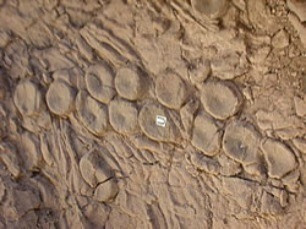Giant Ichthyosaur-Killing Kraken Theory Draws Doubts From Scientific Community

It's a good story - so good, in fact, that it's survived hundreds of years, passed down from the lips of ancient mariners to be incorporated into impressive CGI jet propane-fuelled blockbusters. The legend of the kraken - the terrifyingly huge, violently belligerent giant squid capable of snapping ships in twain with a snap of its tentacles - has endured and tickles our imagination even today. But what evidence is there for the murderous cephalopod?
Mt. Holyoke professor of geology Mark McMenamin believes he's found supporting evidence for the existence of the kraken - though perhaps during a time slightly prior to what recent films Clash of the Titans and Pirates of the Caribbean would have you believe. Dr. McMenamin believes that the fossilized remains of nine 45-foot ichthyosaurs (Shonisaurus popularis) - Triassic period predecessors to today's sperm whales - found at Berlin-Ichthyosaur State Park in Nevada provide indirect evidence for the possibility of the ancient giant. The peculiar arrangement of the fossils has historically been a source of puzzlement for researchers, including Dr. Charles Lewis Camp, one of the country's most renown paleontologists and the world's foremost expert on the Berlin-Ichthyosaur State Park site.
According to a press release distributed by the Geological Society of America, Dr. Camp had theorized that the arrangement of the bones suggested a group death by stranding in shallow water or as the result of exposure to a toxic plankton bloom. However, Dr. McMenamin has a different theory; he believes the odd configuration denotes purposeful rearrangement of the bones - in particular of the round, dinner plate-sized vertebrae. McMenamin then took his hypothesis a step further.
Modern octopus will do this, McMenamin said. Modern octopi are known to leave middens, or gathered leftovers of their prey. The ichthyosaur remains suggested to McMenamin the possibility of giant octopus-like creatures capable of predating upon the animals, which were themselves of an imposing size. I think that these things were captured by the kraken and taken to the midden and the cephalopod would take them apart. McMenamin further suggests that the tightly arranged ichthyosaur vertebrae were a kind of self-portrait assembled by the giant cephalopod.
Yet Dr. McMenamin's theory has been approached with skepticism by many scientists, who say there is little evidence to support it. Dr. PZ Myers, a biologist and associate professor at the University of Minnesota, Morris, said in a blog post on Monday that he believes Dr. McMenamin is exceptionally imaginative.
This Triassic kraken has not been found; no fossils, no remains at all, no evidence of its existence. It is postulated to have been large enough to hunt and kill ichthyosaurs, which is remarkable-comparison to modern giant squid is invalid, since they are prey, not predator. This fossil bed is being over-interpreted as a trace fossil, with the bones arranged by intent, by an intelligent cephalopod, which they have not seen. Furthermore, a line of discs is being seen as a picture of a cephalopod tentacle, classic pareidolia... This is a whole series of tenuous and unlikely speculations stacked together to make an ultimately ridiculous hypothesis.
Dr. McMenamin is presenting his findings today at the 2011 GSA Annual Meeting in Minneapolis.
Do you believe these remains are indicative of a prehistoric kraken? Let us know in the comments below.
© Copyright IBTimes 2024. All rights reserved.











